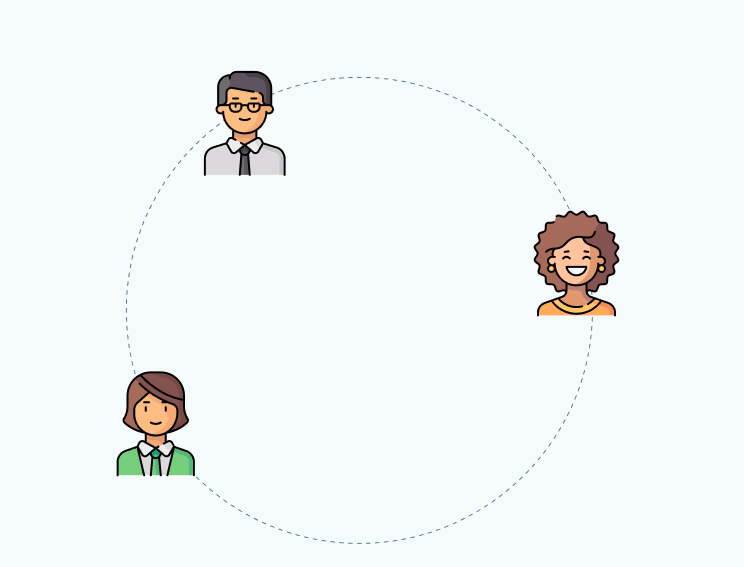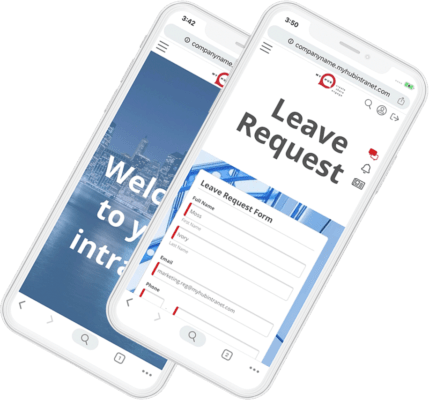
Your New Intranet Starts Here
Streamline communication, boost collaboration, and empower your team with MyHub's intuitive intranet solution.
Book a live demo now and experience the difference.
Take a Quick TourThe human resources team is at the heart of every organization. Traditionally, HR has focused on people and relationships. However, in today’s digital workplace, the nature of those face-to-face interactions is evolving. The Covid-19 pandemic accelerated the global shift toward remote work, and there’s no going back. Now more than ever, HR professionals must leverage modern tools to maintain human connection, foster engagement, and drive internal communications. One of the most effective tools to achieve this is the HR intranet.
In this article, we explore how HR intranet portals meet modern business needs with ten powerful advantages.
What Is An HR Intranet?
An HR intranet is a dedicated internal platform for HR communication and knowledge sharing. It centralizes access to company policies, training manuals, employee benefits, HR updates, and much more, ensuring that both new hires and current staff stay informed and aligned.
Also available as a mobile intranet app, this always-on platform ensures that your workforce remains connected regardless of time zone or location. A mobile-enabled HR intranet significantly improves employee experience and drives platform adoption.
What Are The Benefits Of HR Intranet Portals?
The benefits of using a company intranet for information sharing and internal HR support are well established. Employees can easily access critical resources, including:
- HR policies and procedures
- Job descriptions and recruitment processes
- Onboarding and offboarding protocols
- Employee benefits, wellness programs, and entitlements
- Staff appraisals and performance management
- Annual leave request procedures
- Internal job postings and career growth opportunities
- Training resources and professional development tools
- Employee self-service tools and online forms
But HR portals offer much more than document access. Below are ten ways an intranet can transform your HR operations and support your workforce more effectively.
10 Best Practice Intranet Features To Power Up Human Resources
1. Inspire Workers With Self-Service
Self-service intranet tools offer two critical benefits. First, they empower employees, especially remote workers, to independently access the information they need. Second, they reduce the HR team’s administrative burden by automating common requests.
These efficiencies not only save time but also lead to improved productivity and significant operational cost savings.
2. Streamline Processes
With automated HR workflows, employees can update their own personnel records, request time off, submit expense claims, or complete performance review forms, all without manual intervention.
Automated forms are routed directly to the appropriate manager, minimizing delays and preventing lost paperwork. In addition, intuitive intranet navigation and a powerful search bar ensure that employees can find the information they need quickly, securely, and confidently.
3. Improved Two-Way Communication
Effective two-way communication is vital in a hybrid or remote workplace. With employees spread across locations and time zones, maintaining open communication lines is essential to sustain employee morale and connection.
HR intranets support dynamic communication with features like company blogs, discussion forums, and comment threads. These channels promote transparency, invite feedback, and make employees feel heard, especially important for those working offsite or from home.
Additionally, real-time communication via integrated instant messaging (IM) tools or dedicated team channels allows for faster decision-making and easier access to HR teams. Employees can resolve quick queries without waiting for email responses.
4. Develop Meaningful Relationships
At its core, every business is built on human relationships. The HR department plays a key role in facilitating strong, meaningful connections within the workplace.
The HR intranet becomes the central hub for all recruitment and talent acquisition activities. From job postings and candidate tracking to interview scheduling and onboarding workflows, everything is in one place, digitized and accessible.
This approach ensures a seamless, professional first impression for job applicants, while also reducing administrative overhead for HR. The result? Faster hiring cycles and lower recruitment costs.
5. Deliver Compelling Onboarding Experiences
Effective employee onboarding is a make-or-break moment. The HR intranet simplifies this crucial process with structured workflows, checklists, and online forms that help new hires settle in fast.
New employees can complete tasks like signing policies, setting up payroll, or accessing key team resources at their own pace, often before their first day. A central onboarding hub reinforces company culture, values, and expectations from the outset.
Moreover, incorporating rich media, like videos, podcasts, and interactive guides, creates a more engaging and memorable onboarding experience. This helps new hires become productive contributors from day one, whether they work in the office or remotely.
6. Connect Workers To Each Other
Online staff directories are a powerful tool for strengthening workplace relationships and sharing organizational knowledge. Enhance your employee profiles by adding personal bios, project involvement, and areas of expertise. This humanizes the workplace, allowing colleagues to put a face to a name and discover shared interests, creating stronger interpersonal connections.
These detailed profiles support better collaboration across departments. Employees can easily locate and connect with colleagues in other teams, identify internal subject matter experts, or build cross-functional project teams, without relying on HR intermediaries. It’s a direct path to knowledge sharing, innovation, and faster problem-solving.
Modern HR intranets also feature collaborative project areas where employees can brainstorm ideas, share documents, and provide feedback in real time. These virtual workspaces are ideal for cross-functional collaboration and replace traditional meetings, lengthy email threads, or conference calls. The result? A more agile, creative, and productive organization.
To boost employee interaction further, many companies are adopting social intranet features, including instant messaging (IM), team or personal activity walls, and “follow me” options. These tools create a more engaging digital workplace and foster a sense of community, even in remote or hybrid teams.
7. Build A Strong Employer Brand
A strong employer brand gives you a competitive advantage in recruiting and retaining top talent. The HR intranet is an essential platform for reinforcing your organization’s culture, values, and mission from the inside out.
Ensure your intranet design aligns with your corporate branding. Use consistent colors, fonts, and design elements that mirror your external website. This unified branding builds trust and makes your internal messaging more recognizable and impactful to employees.
Promote internal mobility by advertising job openings on the intranet’s newsfeed. Employees can apply directly through online application forms, streamlining recruitment while reducing costs and minimizing workflow disruption. Internal candidates are already aligned with company values, improving the quality of hires and boosting retention.
Use your intranet to identify emerging leaders. Monitor comments on internal blogs, feedback in forums, and engagement levels, these are valuable indicators of leadership potential. HR can tap into this data to inform talent development and succession planning strategies.
8. Increase Employee Engagement
Employee engagement has a direct impact on productivity, retention, and company performance. Research shows that engaged employees take fewer sick days and are more committed to their roles. That’s why HR teams must lead efforts to enhance engagement using the intranet.
Intranet tools like quizzes, pulse surveys, and opinion polls provide fun and insightful ways to collect feedback. Employees feel more connected and valued when they can contribute to organizational decisions.
Professional development is another cornerstone of engagement. HR intranets streamline the learning journey, from onboarding to ongoing upskilling. Create a centralized learning hub with training materials, development plans, mentoring programs, and external course links. Use forms to track progress and gather feedback in real time.
Celebrate success and boost morale with recognition programs. Showcase achievements via:
- Customer testimonials or reviews on the intranet
- Employee or team of the month features
- Company-wide shoutouts or appreciation posts
- Professional development milestones
- Personal accomplishments outside work, such as community service or sporting events
To assess engagement levels, track key metrics such as turnover, absenteeism, and wellness data via your HR portal. These indicators help spot issues early and guide HR interventions.
Collect deeper insights through online exit interviews. These confidential surveys often yield more honest feedback than in-person discussions. Understanding why employees leave helps refine company culture and prevent future turnover.
9. Better People Focus For Remote Workers
The shift to remote and hybrid work has made it more challenging for HR to maintain its traditional, people-centered role. But with a modern intranet, it’s easier than ever to keep employees connected and engaged.
Employee wellness must now be prioritized, especially for remote staff who may feel isolated. An HR intranet can promote wellbeing by sharing helpful resources, organizing virtual wellness activities, and offering quick-touch communication channels.
- Use the intranet to educate staff and share health & wellbeing content
- Start the day with short team video check-ins or mindfulness sessions
- Create #channels for casual chats and watercooler talk
- Regularly check in with remote workers and offer support
Even simple actions, like listening to concerns or providing a space for informal conversations, can make a big difference for a remote team member struggling with isolation.
10. Provide Gateway Access To All Enterprise Solutions
The best part about a modern HR intranet is its ability to serve as a centralized digital workspace. Employees gain single sign-on access to all essential business tools, enhancing efficiency and user experience.
From Salesforce to Google Workspace and Microsoft 365, users can log in once and access everything they need, no more password fatigue or app-switching chaos.
This seamless integration saves time, boosts productivity, and minimizes IT headaches. Plus, MyHub’s intranet offers unlimited users and data storage, making it a cost-effective, scalable solution for growing organizations.
Ready to transform your HR processes? Get in touch with the MyHub team for a free demo or 14-day trial. Discover just how easy and impactful it is to implement an HR intranet in your organization.
FAQ Section
What is an HR portal on an intranet?
An HR intranet portal is a digital HR hub that combines policies, forms, onboarding, news, and communication channels—accessible anytime via desktop or mobile—integrated within your organization’s intranet.
How does it benefit both HR and employees?
Employees gain self-service access to HR information and tools, while HR teams save time through automation, improved communication, and easier tracking of engagement and metrics.
Can it support remote and hybrid workers effectively?
Absolutely. With mobile access, two-way communication tools, wellness content, and collaboration features, an HR portal ensures remote and hybrid teams stay informed, connected, and valued.






